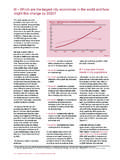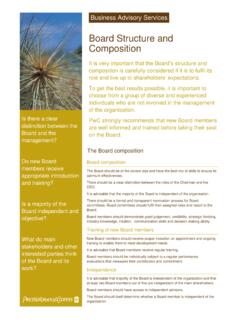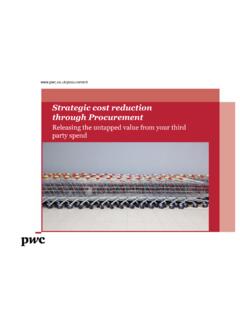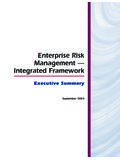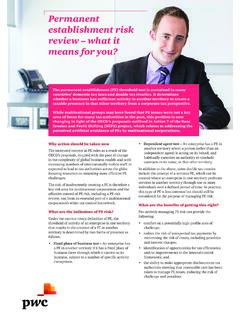Transcription of Similarities and Differences - blogs
1 2005 Similarities and DifferencesA comparison of IFRS, US gaap and UK gaap *Other IFRS publicationsPricewaterhouseCoopers has published the following publications on International Financial Reporting Standards. They areavailable from your nearest pricewaterhousecoopers office or as of Accounting IFRS for the UK 20052 Accounting Briefing newsletterApplying IFRS Finding the right solution (available on PwC inform1)IAS 39 Hedging Aligning theory with practiceIFRS / UK illustrative financial statements 20052 IFRS / UK main Differences indicator June 2005 IFRS Illustrative Consolidated Corporate Financial Statements 2004 IFRS Illustrative Consolidated Financial Statements 2004 BanksIFRS Illustrative Consolidated Financial Statements 2004 InsuranceIFRS Illustrative Consolidated Financial Statements 2004 Investment PropertyIFRS Illustrative Financial Statements 2004 Investment FundsIFRS in the UK: Convergence at a glance3 IFRS in the UK: Latest developments June 20053 IFRS in the UK: PwC inform IFRS site mapIFRS in the UK.
2 Your guide to conversionIFRS Disclosure Checklist 2004 IFRS Measurement Checklist 2004 IFRS News Shedding light on the IASB s activitiesIFRS Pocket Guide 2004 IFRS: Ready for take-off? a survey of over 300 companies readiness for IFRSI llustrative Interim Financial Statements for First-time AdoptersShare-based Payment A practical guide to applying IFRS 2 SIC-12 and FIN 46R the substance of controlWorld Watch Governance and Corporate Reporting1 You can register for a 60-day free trial of PwC inform ( ) by calling +44 (0) 20 7213 4030 or can purchase these books by completing the online registration form accessible from (select Publications)3 Only available on the PwC inform websiteContact your nearest pricewaterhousecoopers office for a hard copy of all the other listed publications or e-mail our Publicationsdepartment on PricewaterhouseCoopersTo discuss any of the issues raised with one of pricewaterhousecoopers experts, please refer to the list of names at the back ofthis publication or speak to your usual pricewaterhousecoopers ( )
3 Provides industry-focused assurance, tax and advisory services for public and private clients. More than 120,000people in 144 countries connect their thinking, experience and solutions to build public trust and enhance value for clients and their stakeholders. 2005 pricewaterhousecoopers . All rights reserved. pricewaterhousecoopers refers to the network of member firms of PricewaterhouseCoopersInternational Limited, each of which is a separate legal entity. Designed by Studio ec4 17632(08/05).*connected thinking is a trademark of pricewaterhousecoopers of Similarities and differences3 Accounting framework19 Financial statements21 Consolidated financial statements28 Business combinations35 Revenue recognition43 Expense recognition47 Assets53 Liabilities68 Equity78 Derivatives and hedging79 Other accounting and reporting issuesForeign currency translation83 Earnings per share86 Related-party transactions87 Segment reporting88 Discontinued operations91 Post-balance-sheet events92 Interim financial reporting93 Insurance94 Index98 ContentsSimilarities and Differences A comparison of IFRS, US gaap and UK gaap August 2005 PrefaceInternational Financial Reporting Standards (IFRS) will be adopted for the first time in2005 by all UK listed groups and some unlisted groups and companies.
4 The InternationalAccounting Standards Board (IASB) has been busy putting in place a stable platform ofIFRS for first-time adopters. Since 2002, the IASB and the US Financial AccountingStandards Board (FASB) have been committed to working towards converging the twoframeworks. Despite convergence initiatives, there are many Differences between thetwo frameworks, which this publication seeks to , the UK s Accounting Standards Board (ASB) has been working to graduallyconverge UK gaap with IFRS. This has resulted in the issue of seven new UKaccounting standards based on their international equivalents in 2004 and plans for theissue of more over the coming months and publication provides a means by which companies can quickly identify keysimilarities and Differences between IFRS, US gaap and UK under all three frameworks are ongoing, and this publication has beenupdated to fully reflect the final standards required for hope this latest version of the publication helps you keep pace with the changes andassists in identifying the Similarities and Differences that exist between IFRS, US GAAPand UK Holgate Senior Partner UK Accounting TechnicalPricewaterhouseCoopersPrefaceiS imilarities and Differences A comparison of IFRS.
5 USGAAP and UK gaap August 2005 IntroductionThis pricewaterhousecoopers publication is for those who wish to gain a broad understanding of the key similaritiesand Differences between three accounting frameworks: International Financial Reporting Standards (IFRS), USGenerally Accepted Accounting Principles (US gaap ) and UK Generally Accepted Accounting Principles (UK gaap ).The first section provides details of the plans to converge UKand US gaap with IFRS. The second section provides asummary of the Similarities and Differences betweenIFRS, US GAAPand UK GAAPand refers to subsequent sectionswhere key divergences are highlighted and the likely impact of recent proposals are summary publication can do justice to the many Differences of detail that exist betweenIFRS, US GAAPand UK if the guidance is similar, there can be Differences in the detailed application, which could have amaterial impact on the financial statements.
6 In this publication, we have focused on the measurement Similarities anddifferences most commonly found in practice. When applying the individual accounting frameworks, readers mustconsult all the relevant accounting standards and, where applicable, their national law. Listed companies must alsofollow relevant securities regulations for example, the Listing Rules of the United Kingdom Listings Authority orother applicable stock exchange listing publication takes account of authoritative pronouncements issued underIFRS, US GAAPand UK gaap up to31 December 2004 (for US gaap ,the relevant date is 30 June 2004) and is based on the most recent version ofthose pronouncements, should an earlier version of a pronouncement still be operative at the date of this NOTE:This publication does not take account of the following developments in IFRS, which had not been made into authoritative pronouncements as of 31 December 2004: Amendment to IAS 39 Financial Instruments: Recognition and Measurement Cash flow hedge accounting offorecast intragroup transactions Amendment to IAS 39, Financial Instruments.
7 Recognition and Measurement Transition and initial recognitionof financial assets and financial liabilities Amendment to IAS 39, Financial Instruments: Recognition and Measurement The fair value option ED7, Financial instrument disclosures IFRIC D5, Applying IAS 29, Financial reporting in hyperinflationary economies for the first time IFRIC D6, Multi-employer plans IFRIC D7, Scope of SIC-12 consolidations Special purpose entities IFRIC D9 , Employee benefit plan with a promised return on contributions or notional contributions IFRIC D10, Waste electrical and electronic equipment IFRIC D11, Changes in contributions to employee share purchase plans (IFRS 2) IFRIC D12, Service concession arrangements Determining the accounting model IFRIC D13,, Service concession arrangements The financial asset model IFRIC D14, Service concession arrangements The intangible asset model IFRIC D15, Reassessment of embedded derivatives IFRIC D16, Scope of IFRS 2 IFRIC D17, IFRS 2 Group and treasury share transactions Discussion paper Preliminary views on accounting for small and medium-sized entitiesIntroductionSimilarities and Differences A comparison of IFRS, US gaap and UK gaap August 2005iiConvergenceBoth the Accounting Standards Board (ASB) in the UK and the Financial Accounting Standards Board (FASB) in theUS are working with the International Accounting Standards Board (IASB)
8 To converge UK GAAPand US gaap respectively with ConvergenceThe following key initiatives aim to further the goal of convergence between IFRSand US gaap , in addition to theIASB and the FASB s monitoring of the activities of the other board and their explicit consideration of the otherboard s agenda decisions:Joint projects are the projects that both boards have agreed to conduct simultaneously in a co-ordinated manner. They involve sharing staff resources, and every effort is made to keep joint projects to a similartime schedule. The IASB and the FASB are currently conducting joint projects to address revenue recognition andbusiness combinations. The short-term convergence short-term convergence project is an active project that is beingconducted jointly between the IASB and the FASB. The scope of the short-term convergence project is limited tothose Differences between IFRSand US GAAPin which convergence around a high-quality solution appearsachievable in the short-term.
9 Because of the nature of the Differences , it is expected that a high-quality solution canusually be achieved by selecting either existing IFRSor US convergence research FASB staff is currently working on a research project related to project seeks to identify all of the substantive Differences betweenUS GAAPand IFRSand to catalogue thosedifferences. The project s scope includes Differences in standards addressing recognition, measurement, presentationand disclosure. Any topic in which a specific accounting treatment would be permissible under one basis of accountingbut would not be permissible under the other basis of accounting is included in the significant progress towards international convergence is expected to be made in the next few years, thevolume of Differences and the complex nature of some issues means that many Differences between IFRSand US gaap will remain well beyond ConvergenceFor UK listed companies, group accounts are required to be prepared under EU adopted IFRSfor accountingperiods beginning on or after 1 January 2005.
10 Furthermore, other private UK companies and groups have the optionto adopt IFRS. However, UK company law now requires consistency of application of IFRSor UK GAAPfor allcompanies within these groups. The options for using EU-adopted IFRS operate separately for consolidated andindividual financial statements. It is therefore permissible for companies to use EU-adopted IFRSin theirconsolidated financial statements whilst using UK GAAPin their individual financial statements or vice versa (exceptthat listed companies must use EU-adopted IFRSin their consolidated financial statements). All UK group companies must, however, adopt the same accounting framework in their individual accounts (unlessthere are good reasons for not doing so), except that the parent can use EU-adopted IFRSin its individual financialstatements without this triggering a requirement for all the subsidiaries to use EU-adopted IFRS, but only if theparent has used EU-adopted IFRSin its consolidated financial ASB intends to achieve convergence of UK standards with IFRSas quickly as possible whilst avoiding theburden of excessive changes in any one year and, in particular, minimising the cases in which an entity using UKstandards may be required to make successive changes of accounting policy in respect of the same matter.
